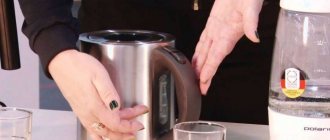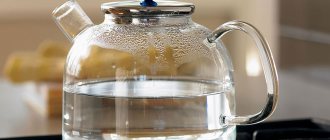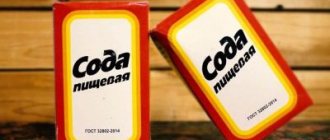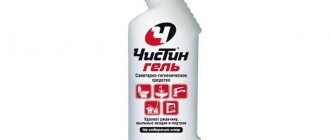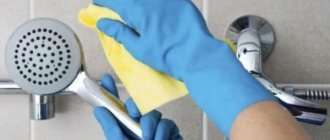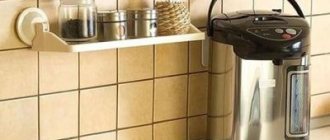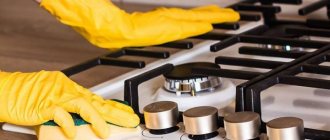An electric kettle is a great helper in the kitchen. It can be used to boil water in a few minutes.
In order for the device to function properly, it must be properly cared for. First of all, this concerns the removal of limescale, which regularly forms on its walls.
Read the article about how to quickly and safely remove scale from an electric kettle at home.
Why is scale dangerous?
The appearance of deposits is associated with the use of hard water. Often even filtered water produces a small amount of scale.
The “overgrown” inner walls of the kettle present a pitiful sight. Solid layers of carbonates (crystallized calcium and magnesium salts) settle inside the flask, on heating elements, and form a precipitate in the water in the form of whitish flakes.
Plaque covers the walls, spirals or disc, slowing down the heating of the liquid, increasing the boiling time, and, consequently, energy consumption.
Tea brewed in such water has foreign impurities, odors, and is tasteless. There are no scientifically proven facts about the dangers of hard water for the human body, but drinking a tasteless drink (due to a dirty kettle) is not very pleasant.
Lime deposits covering the walls and heating elements impair the heat transfer of the device. The kettle works at the limit, makes a lot of noise when it boils, and breaks down faster. Do not underestimate the harm of scale; it is better to clean the device regularly and not let it become a karst cave.
How often should you clean your kettle?
The frequency of the procedure depends on the nature of the device’s operation and the quality of the water. With soft or filtered water, it is enough to carry out the procedure once every 1.5-2 months. If the water is too hard, you will need to clean the device 1-2 times a month, as needed.
The rate of formation of lime deposits directly depends on the composition of the water
Cleaning an electric kettle: what to pay attention to
At home, household chemicals are suitable for cleaning the inside of the device; they are available in large quantities on the shelves of hardware stores. Compositions based on folk recipes that have been tested in practice and do not require large financial expenses give good results.
Before you remove scale from an electric kettle, you need to understand its structure and take into account its design features. The body and flask of devices, if any, are made of different materials (glass, stainless steel, plastic, ceramics), so not every composition is suitable for cleaning.
Do not use steel wool, knives, or hard brushes, as you can easily damage the surface of the reservoir, spirals, and disk, and you will have to replace the device. Electronically controlled models are especially carefully cleaned.
When removing scale, mechanical methods are excluded, and abrasive powders are not used.
Do water filters save you?
I used a similar water filter.
At first I tried to outwit nature, I’m the smartest, and use a water filter, you know, a jug like that (if I’m not mistaken, the name of this miracle of engineering is “Barrier”). You pour water into it into the upper container, and it slowly flows through the filter and at the bottom is already clean, clean (well, that’s what they told me at the store). My disappointment knew no bounds, maybe there was a tiny effect, but, to be honest, I didn’t notice it.
Effective cleaning products
The simplest and easiest way to remove recent deposits is small lime deposits that have not had time to “harden”. You will have to tinker with old scale, so if you use hard water for boiling, wash the kettle from the inside at least once a week.
Available means are used:
- soda;
- table vinegar (6-9%);
- citric acid powder;
- apple peel;
- peeling potatoes;
- carbonated drinks.
After cleaning with any composition, the kettle must be washed, boiled 2-3 times, draining the liquid, and only then water for tea is collected.
Folk recipes
You can deal with deposits in an electric kettle using improvised means. To the rescue comes:
- citric and oxalic acid,
- soda,
- vinegar and even sweet sparkling water.
To prevent the process of fighting scale from ending sadly, you need to use the compounds correctly.
Read more about descaling your kettle here.
How to remove with citric acid?
Citric acid gently and effectively removes lime deposits . To prepare the solution, take 10 g of powder for each liter of water. If the scale layer is thick, then the amount of preservative is increased to 20 g.
The contents of the bag are poured into the kettle, filled with water and turned on. When the liquid is brought to a boil, stop heating.
Allow the product to work and drain it after about an hour . The kettle is washed, filled with new water, boiled, rinsed again, and then used as usual. Read more here.
Vinegar
Vinegar is as effective as citric acid. To treat the device, a preservative with a concentration of 9% is used. For 1 liter of water you will need 200 ml of vinegar.
The solution is poured into a kettle, boiled, left to cool completely and drained. If the layer was small, then you will be able to cope with it on the first try. To get rid of old deposits, the procedure will need to be repeated 2-3 times. Additionally, you can clean the inside of the kettle with a soft sponge. You can find out more here.
When heated, vinegar emits a pungent odor. Therefore, cleaning should be done in a well-ventilated area.
How to clean with soda?
You can get rid of limescale using baking soda. This gentle product is not highly effective in combating old deposits, but it can deal with a small layer of scale.
To carry out the procedure you will need 1 liter of water and 5 tablespoons of soda . The solution is boiled, kept for 2 hours and drained. The walls of the kettle are rinsed with clean water. If necessary, use a foam sponge. Read more here.
Oxalic acid
Oxalic acid makes deposits loose, promoting their rapid dissolution. To remove limescale, it is better to use store-bought concentrate rather than fresh sorrel. The herb is effective only for preventive purposes.
Mode of application:
- Fill the kettle with water so that it covers the entire lime layer.
- Add oxalic acid to the water. For 1 liter you will need 10 - 15 g.
- Bring the solution to a boil.
- Turn off the appliance and allow the cleaning agent to cool.
- Drain the composition, walk over the surface of the heating element and the walls with a soft sponge.
- Rinse the kettle, pour clean water into it, boil and drain.
To get rid of a thick layer of scale, cleaning must be done at least 2 times.
How to quickly clean the walls with Coca-Cola, Sprite or Fanta?
Carbonated drinks such as Coca-Cola, Fanta and Sprite contain phosphoric acid. This substance dissolves salt deposits well, making them soft. Therefore, with the help of popular drinks you can cope with even a thick layer of scale.
The procedure is carried out as follows:
- pour soda into the kettle;
- leave it open for 20 minutes to allow excess gas to escape;
- turn on the device, bring the liquid to a boil;
- when the solution has cooled completely, it is drained;
- The kettle is rinsed with warm water.
As a rule, carbonated drinks are so effective that after using them the kettle shines with its original cleanliness. Repeated treatment may be required only in the most advanced cases. Read more about the method in this article.
Peeling potatoes or apples
Apple and potato skins will help cope with salt deposits if they have just begun to form. This method is suitable for preventative cleaning, as well as for those people who are afraid to use caustic descaling products.
Mode of application:
- Clean, washed peels are poured into the kettle.
- Fill it with water until it covers the layer of scale.
- Bring the liquid to a boil 2-3 times.
- Leave to cool.
After emptying the kettle, its walls are thoroughly cleaned with a non-metallic brush. The main advantage of this method is the absence of costs.
How can you remove plaque with cucumber or tomato pickle?
You can deal with lime deposits using brine from canned cucumbers or tomatoes. It contains several active components:
- vinegar,
- salt,
- acid produced by vegetables.
Therefore, the product is not inferior in effectiveness to lemon juice.
Mode of application:
- pour brine into the kettle;
- bring it to a boil;
- leave for 30 minutes and drain;
- Rinse the kettle thoroughly using soda and boil it with clean water.
The main disadvantage of brine is the specific smell that appears when heated. To prevent it from spreading throughout the apartment, the kitchen must be thoroughly ventilated.
Stainless steel
Practical and durable steel kettles are cleaned using chemical compounds. Traditional recipes include options with soda, vinegar, fruit and vegetable peelings, and soda.
Light deposits can be cleaned with a brush, but it is better not to risk it and use liquid compounds. A solution with soda and laundry soap shavings removes dirt well. After boiling, the mixture is drained and the walls are rubbed until shiny with a sponge.
Method number 6. We use marinade or brine from preservation
The brine or marinade contains vinegar or citric acid, and they perfectly soften or completely dissolve plaque. In addition, the marinade will do an excellent job of removing rust inside the electric kettle and will bring all metal parts to a shine.
Cleaning a kettle from scale with canned brine does not involve any particular difficulties: pour it into a container, heat it to a vigorous boil, and let it cool. If one procedure does not bring the desired result, it can be repeated. The only caveat is that the brine has a very spicy smell; to neutralize it, you will have to boil clean water and rinse the dishes well.
Glass teapots
Devices with transparent walls require special attention and regular cleaning. Any dirt is visible in such kettles, and if you forget about maintenance, the beautiful device will quickly become overgrown with scale.
The most popular options: soda, citric acid (or natural citrus), salt, laundry soap. Vinegar and brine are used for old stains - just like soda. Household chemicals - only according to the instructions, if glass is specified in the area of application.
Features of cleaning heating elements
Removing scale from an electric kettle requires care. The fact is that the devices are equipped with different types of heating elements.
It can be:
- spirals (open, closed);
- disk.
In each case, different cleaning methods are used, otherwise the heater can be easily damaged.
Helpful information
get rid of scale successfully :
Do not use a hard metal brush or sharp objects to remove plaque. They can damage the walls of the device.- After finishing the treatment, it is not enough to simply rinse the kettle. You need to fill it with clean water, boil it and drain it. Only after this can you safely use the device for its intended purpose.
- The exposure time of the cleaning agent must not be exceeded. This is especially important when using professional household chemicals.
Read about methods for descaling in this section.
Open spiral
A tubular electric heater (TEH) is located in the lower part of the device body; its design resembles a familiar boiler. It is made from stainless steel, as well as from steel with a nickel or chrome plated finish.
The heating element comes into contact with water, so hardness salts quickly settle on it. Plaque reduces heat transfer, the device works hard, consuming a lot of energy when boiling.
In expensive models, spirals can be made of titanium alloy, brass, and even gold-plated. Scale does not accumulate on such heating elements, since the materials are characterized by a self-cleaning function.
To remove limescale in electric kettles with an open heating element, use soda solution, citric acid, or a carbonated drink. Small deposits can be removed by boiling salt and soap. It is advisable not to use vinegar and brine, as they corrode not only the carbonate layers, but also the surface of the spiral. In order for the kettle to serve for a long time, it is recommended to clean the container more often and use filtered water for boiling.
How to get rid of rust?
In difficult cases, when you have to deal not only with lime, but also need to wash off rust, a three-stage cleaning will help:
- The first time the device is boiled with baking soda in a ratio of 1 large spoon per liter of water.
- The second time, boiling is carried out with citric acid in the same proportions.
- The procedure is completed by boiling with table vinegar - 100 ml per liter of liquid.
Each time, the boiled liquid is left to stand for 15-20 minutes, drained and the device is washed.
If rust has formed on the outer surface of the appliance, you can use washing powder. It is poured onto the soft side of a kitchen sponge, rubbed against the rust and left for half an hour to react.
Were the tips in the article helpful to you?
Not really
Closed spiral
The heating element is of exactly the same design as the closed type, but it is “hidden” under the metal bottom of the kettle. There is no direct contact with water, so the spiral does not become coated. All scale and dirt remains on the walls and bottom of the device, and this also slows down the heating and boiling process.
Any of the above cleaning methods are suitable for such models. The main thing is to consider what material the device body is made of and follow the recommendations for dosage and proportions.
How to clean limescale in an electric kettle using household chemicals
Let's look at the procedure for processing a plastic and metal kettle.
Cleaning a plastic electric kettle from scale
To get rid of dirt in a plastic product, do not use soda and vinegar. But citric acid will do the job perfectly. The method is universal; it is suitable for both metal coatings and plastic.
If a thin layer of deposits is noticeable on the walls and spiral of the kettle, then you don’t have to boil the water. It is necessary to measure 1 liter of clean water, pour 20 g of lemon crystals into it, and mix. The resulting mixture is poured into the device and left to soak. Most often, 3-4 hours are enough. The deposits should fall off on their own.
If this does not happen, then you need to turn on the equipment and wait for it to boil. Now removing all the scale will not be difficult.
To get rid of dirt in a plastic product, do not use soda and vinegar.
How to clean a metal electric kettle
To avoid problems with malfunctions of a metal device, you need to take care of it and clean it in a timely manner. But if scale has formed, it is recommended to use the following instructions:
- The electrical appliance is disconnected from the network. It needs to cool down;
- When cleaning, use mechanical or chemical methods. The first may complement the other. To get rid of carbon deposits, brushes made of artificial bristles, wood, plastic, and silicone are used manually. The surface treatment of the water heating element must be carried out carefully; scale must be removed evenly. If deposits remain, the water will heat unevenly, energy consumption will increase, and the device may burn out. Under no circumstances should you use sandpaper or a file - there is a high probability of damaging the metal coating. The next layer, which will fall on the previous one, will be very difficult to wipe off;
- In the chemical method, acids and solvents are used. Treatment with agents, depending on the concentration, can be regular or urgent radical;
- The device is equipped with a mesh closer to the spout, which prevents sediment from penetrating into the mug. This filter must be cleaned regularly.
Having finished scrubbing the kettle of scale, boil the water in it twice. Rinsing occurs under running water.
To avoid problems with malfunctions of a metal device, you need to take care of it and clean it in a timely manner.
When using tap water, the electric kettle quickly becomes covered with a layer of plaque. This is explained by the fact that when boiling, a lot of salts are released, which gradually settle on the walls of the device and the heating element. Not everyone understands the seriousness of this problem. Contamination not only reduces the service life of equipment, but also deteriorates human health. It is important to timely treat the internal surface of an electrical appliance.
Disc heater
The plate to which the electrical contacts are connected is considered more hygienic, easy to clean (easy to clean from scale and dirt), and faster in terms of boiling speed. The cost of devices with disk heaters is higher than devices with open heating elements, but the price is justified.
Typically, such models operate on a stand (base) with the ability to rotate 360 degrees. It's convenient and practical. For comparison: models with an open spiral can often be placed on the base only in a strictly defined position.
Any methods listed in the section above are suitable for removing lime deposits. Cleaning solutions do not come into contact with the contacts and do not cause damage to the heater.
Washing electric kettles of any type in the dishwasher is prohibited!
Method number 2. How does soda work?
Household or baking soda is very popular among the population because its scope is quite wide. The multifunctional cleaning agent is also widely used to soften limescale deposits. If you decide to descale the kettle with soda, fill it with fresh running water to the maximum set level, then add 1 tsp. household soda ash or baking soda. Boil until the surface is clean. The resulting solution should stand on low heat for up to half an hour. After cleaning, rinse the container, boil again and drain the water for the final rinse. This will remove all remaining powder completely.
It is not recommended to use this method for electrical devices.
You can use baking soda as a mild abrasive cleanser to remove scale. If there are not a lot of deposits, one teaspoon is enough. In addition, household soda is excellent for cleaning carbon deposits from a gas stove, but it should be used carefully so as not to spoil the surface.
Preventing scale formation
In order not to find the most economical and effective means and methods for ridding your favorite kettle of corrosive scale, do not forget about prevention.
Helpful Tips:
- try to draw water only before boiling, and then drain the remainder;
- To soften hard water, it is recommended to install special filters in the kitchen;
- If there is no cleaning system, then you need to pour water into containers in advance and let it settle. Another option is to buy a bottled product, but only from trusted suppliers;
- Every time after drinking tea, you should wash the kettle and rinse thoroughly;
- Do not boil water several times;
- Clean the container regularly using baking soda or mild detergents.
Housewives usually know well the characteristics of the water used in their apartment or house. At high hardness levels, it is necessary to install filtration systems, otherwise a constant fight against scale will be ensured not only in the kettle, but also in all kitchen utensils.
Consider the options and possibilities of ordering water, at least for drinking and cooking, and do not forget about regular washing and removing deposits. Rinse the kettle every day and then you won’t have to deal with old scale.
Why does scale form?
Yes, by the way, I was enlightened a little here. I kept wanting to understand where it comes from in the kettle, this scale, the water seems to be clean. In general terms, it looks like this: chemistry is involved here, and for those who have recently been in school, it will not be difficult to understand. The water you heat in a kettle contains salts: calcium, magnesium and much more. When heated, they decompose into carbon dioxide and an insoluble precipitate. This sediment is scale, which settles on the bottom and walls. The harder the water, the more salts it contains and, accordingly, the more terrible the scale will look.
Addition – clean external carbon deposits and grease
Enamel, stainless steel and aluminum are covered with soot and soot on the outside. This spoils the appearance. First, try cleaning with detergent and a sponge. But if all else fails, they begin to use hard artillery.
Option 1. Boiling in soda solution
First, collect water in a large metal container (so that the item being cleaned will fit). Make a solution at the rate of 1 tbsp. l. for 1l. Lower the stainless steel bowl and leave it in the bubbling water for 30 minutes, then cool. Then clean the surface under running water with a hard sponge.
Option 2. Cleaning with soda slurry
For the operation you need to heat the kettle. Don't overdo it - you should feel comfortable holding it in your hands. While the kettle is heating, make a soda slurry with water: 3 parts soda to 1 part water.
Apply the paste to the surface, do not touch for 5 minutes. and now rub with the hard side of the napkin.
Option 3. For aluminum and stainless alloy items
To clean, you will need to make a solution: 3 tbsp. l. (vinegar 9%) and 1l. (water). The container is boiled for 20 minutes, cooled and washed.
Method 5. How to remove scale from a kettle using apple or potato peelings
This product is suitable either for preventative care or if the limescale deposits are still weak.
The method is suitable for: descaling ordinary enamel and metal kettles.
Ingredients: apple, pear or potato peelings.
Recipe: place apple, pear or washed potato peelings in a kettle, fill with water and bring to a boil. As soon as the water boils, leave the peel to cool for 1-2 hours, and then wash off the softened plaque with a sponge.
What you need to know
Salt deposits and mineral particles slow down the operation of the electric kettle and worsen the taste of the water. Therefore, cleaning should not be delayed for long. In addition, weak plaque is much easier and faster to remove.
- Do not neglect the use of gloves when in contact with caustic substances.
- It is not advisable to use abrasives, brushes and scrapers - this will create microdamages on the inner surface of the kettle.
- To prevent the remains of caustic substances from entering the body, the water in the kettle should be boiled and poured out. Carry out this washing three times before use. The water must be clean every time.
Before starting work, warn everyone with whom you share the device. This is important to avoid accidental poisoning or burns from the cleaning products used.
